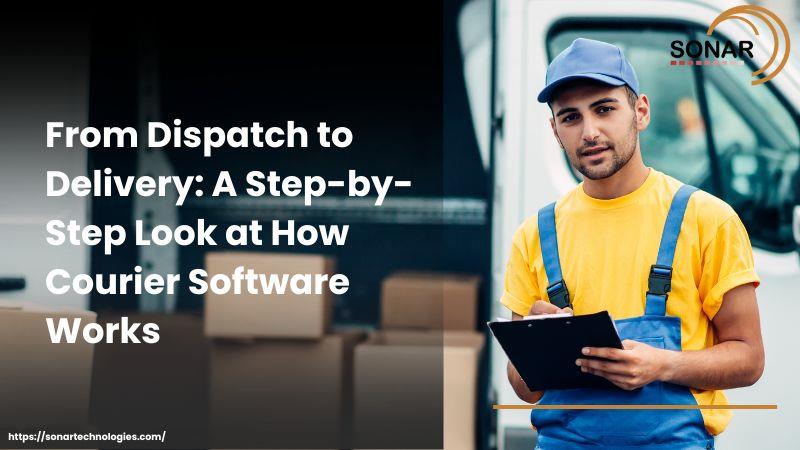Speed and accuracy in the logistics industry are not only strengths — they’re requirements. Courier companies require more than vans on the road and clipboard-wielding employees; they require robust digital tools that automate everything from smart workforce management to dispatch and delivery. That’s what courier management software is for — not as a back-office tool,
but as the foundation of the entire delivery business.
Let’s closely examine how Courier Delivery Management Software nowadays operates step by step — from the scheduling of a delivery to the moment a parcel is in the hands of the customer.
Step 1: Order Entry and Job Booking
The process begins when a delivery request is requested. This might be submitted through an API, customer portal, mobile app, or through internal staff manually typing it into the system. The software captures all the applicable information — pickup and drop-off locations, package size, delivery time slots, customer preferences, and special requests, right away.
Advanced Courier Delivery Management Software verifies automatically the accuracy of addresses and notifies users of missing data, saving time and reducing errors upfront.
Step 2: Smart Dispatching
When the order is confirmed, it advances to the dispatch phase. Intelligent algorithms come into play at this point. The software considers:
- Courier availability
- Current location and proximity to pick up points
- Traffic and road conditions
- Delivery priority levels
Instead of manually assigning jobs, the program dynamically assigns the pickup to the most suitable driver. This optimisation saves time, decreases fuel expenses, and increases courier efficiency.
Step 3: Real-Time Tracking and Communication
As soon as a courier collects a parcel, the Courier Delivery Management Software automatically updates the status of the delivery. Real-time tracking through GPS starts and both the end-customer and the dispatcher can track where the package stands in the delivery pipeline. Courier delivery software facilitates real-time communication between dispatchers and drivers— whether it’s redriving because of traffic, logging delays, or updating ETAs. In-app live notifications and messaging facilitate communication without the need for phone calls or texts.
Step 4: Dynamic Route Optimisation
Courier software doesn’t just end at dispatch — it actively assists couriers in picking optimal routes as they drive. Dynamic routing tools adjust to:
- Real-time traffic
- Road closures
- Weather conditions
- Multi-stop deliveries
In case of multi-drop deliveries, the courier delivery software optimises stops with regard to distance, delivery windows, and load capacity — all while maintaining fuel efficiency and timely delivery.
Step 5: Proof of Delivery (POD)
When a package is delivered, the courier can instantly capture digital proof. This may include electronic signature, barcode scan, image, timestamp, or all these above.
This Proof of Delivery (POD) is securely saved in the system and released to customers in real time. No lost paper receipts or slow confirmations. It creates transparency, trust, and legal compliance through one easy process.
Step 6: Billing and Reporting
Courier software also streamlines billing with automatic invoices generated based on levels of service, distance, weight of package, and delivery time. It provides integration with accounting software to ensure finances are in sync.
Meanwhile, strong reporting dashboards enable companies to monitor:
- Delivery performance
- Driver efficiency
- Delivery success rates
- Customer satisfaction metrics
- Operational costs
These provide logistics managers with the ability to spot inefficiencies, plan more effectively, and grow confidently.
Step 7: Customer Alerts and Feedback
Customer communication does not stop after the parcel has been dropped. Courier management systems provide automated delivery confirmation e-mails or SMS notifications and can include satisfaction surveys or fault reporting functionality.
Customer experience is critical in logistics, and this final touchpoint closes the loop professionally while offering opportunities for service improvement.
Future-Proof Your Logistics with the Right Courier Delivery Management Software
The modern logistics landscape isn’t just about getting from point A to point B — it’s about doing it smarter, faster, and more transparently. From job booking to final delivery and billing, every step of the courier journey is now powered by advanced Courier Delivery Management Software.
The businesses that lead in this space are the ones that have embraced automation, real-time visibility, and scalable systems tailored to their operational demands.
That’s why selecting the right courier delivery software is not just an IT decision — it’s a business strategy. The right system streamlines communication, optimises dispatching, reduces costs, and ultimately delivers better customer satisfaction. For companies growing across cities or regions, it offers operational consistency and adaptability to dynamic market conditions.
Courier delivery management software should grow with your business, integrate seamlessly with your existing tools, and support localised workflows that truly reflect your logistics environment.
This is exactly what Sonar Technologies delivers. For over two decades, Sonar Technologies has empowered Australian courier and logistics companies with purpose-built, enterprise-grade software solutions. Whether you’re scaling up deliveries, launching a new courier service, or needing to streamline fleet performance, Sonar provides the tools to transform your logistics from the ground up.
Explore how Sonar’s Courier Delivery Management Software can become the digital backbone of your logistics operation — built for reliability, efficiency, and growth in today’s competitive delivery economy.

